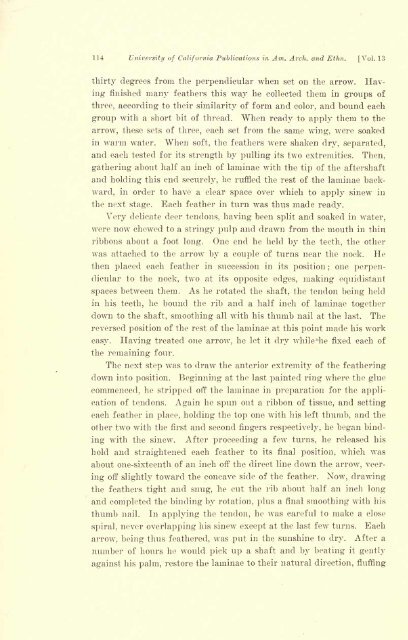Saxton Pope - Yahi Archery.pdf - Primitiv-bogen.de
Saxton Pope - Yahi Archery.pdf - Primitiv-bogen.de
Saxton Pope - Yahi Archery.pdf - Primitiv-bogen.de
You also want an ePaper? Increase the reach of your titles
YUMPU automatically turns print PDFs into web optimized ePapers that Google loves.
11-4 University of California Publications in Am. Arch, and Ethn. [Vol. 13thirty <strong>de</strong>grees from the perpendicular when set on the arrow. Having finished many feathers this way he collected them in groups ofthree, according to their similarity of form and color, and bound eachgroup with a short bit of thread. When ready to apply them to thearrow, these sets of three, each set from the same wing, were soakedin warm water. When soft, the feathers were shaken dry, separated,and each tested for its strength by pulling its two extremities. Then,gathering about half an inch of laminae with the tip of the aftershaftand holding this end securely, he ruffled the rest of the laminae backward, in or<strong>de</strong>r to have a clear space over which to apply sinew r inthe next stage. Each feather in turn was thus ma<strong>de</strong> ready.Very <strong>de</strong>licate <strong>de</strong>er tendons, having been split and soaked in water,were now chewed to a stringy pulp and drawn from the mouth in thinribbons about a foot long. One end he held by the teeth, the otherwas attached to the arrow by a couple of turns near the nock.then placed each feather in succession in its position ;one perpendicular to the nock, two at its opposite edges, making equidistantspaces between them. As he rotated the shaft, the tendon being heldin his teeth, he bound the rib and a half inch of laminae togetherdown to the shaft, smoothing all with his thumb nail at the last. Thereversed position of the rest of the laminae at this point ma<strong>de</strong> his workeasy. Having treated one arrow, he let it dry while he fixed each ofthe remaining four.The next step was to draw the anterior extremity of the featheringdown into position.HeBeginning at the last painted ring where the gluecommenced, he stripped off the laminae in preparation for the application of tendons. Again he spun out a ribbon of tissue, and settingeach feather in place, holding the top one with his left thumb, and theother two with the first and second fingers respectively, he began binding with the sinew. After proceeding a few turns, he released hishold and straightened each feather to its final position, which wasabout one-sixteenth of an inch off the direct line down the arrow, veering off slightly toward the concave si<strong>de</strong> of the feather.Now, drawingthe feathers tight and snug, he cut the rib about half an inch longand completed the binding by rotation, plus a final smoothing with histhumb nail. In applying the tendon, he was careful to make a closespiral, never overlapping his sinew except at the last few turns. Eacharrow, being thus feathered, was put in the sunshine to dry. After anumber of hours he would pick up a shaft and by beating it gentlyagainst his palm, restore the laminae to their natural direction, fluffing


